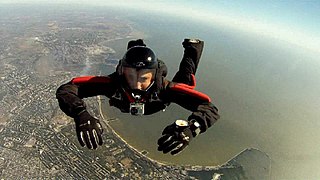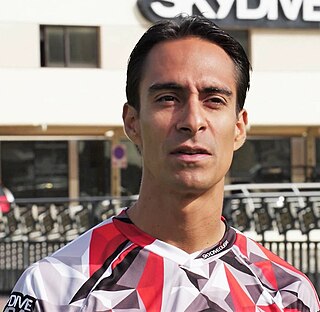
Parasailing, also known as parascending or parakiting, is a recreational kiting activity where a person is towed behind a vehicle while attached to a specially designed canopy wing that resembles a parachute, known as a parasail wing. The manned kite's moving anchor may be a car, truck, or boat. The harness attaches the pilot to the parasail, which is connected to the boat, or land vehicle, by the tow rope. The vehicle then drives off, carrying the parascender and person into the air. If the boat is powerful enough, two or three people can parasail behind it at the same time. The parascender has little or no control over the parachute. The activity is primarily a fun ride, not to be confused with the sport of paragliding.

A parachute is a device used to slow the motion of an object through an atmosphere by creating drag. Parachutes are usually made out of light, strong fabric, originally silk, now most commonly nylon. They are typically dome-shaped, but vary, with rectangles, inverted domes, and others found. A variety of loads are attached to parachutes, including people, food, equipment, space capsules, and bombs.

Paragliding is the recreational and competitive adventure sport of flying paragliders: lightweight, free-flying, foot-launched glider aircraft with no rigid primary structure. The pilot sits in a harness or lies supine in a cocoon-like 'speed bag' suspended below a fabric wing. Wing shape is maintained by the suspension lines, the pressure of air entering vents in the front of the wing, and the aerodynamic forces of the air flowing over the outside.

The Rogallo wing is a flexible type of wing. In 1948, Francis Rogallo, a NASA engineer, and his wife Gertrude Rogallo, invented a self-inflating flexible wing they called the Parawing, also known after them as the "Rogallo Wing" and flexible wing. NASA considered Rogallo's flexible wing as an alternative recovery system for the Mercury and Gemini space capsules, and for possible use in other spacecraft landings, but the idea was dropped from Gemini in 1964 in favor of conventional parachutes.

Powered paragliding, also known as paramotoring or PPG, is a form of ultralight aviation where the pilot wears a back-mounted motor which provides enough thrust to take off using a paraglider. It can be launched in still air, and on level ground, by the pilot alone — no assistance is required.

Canopy piloting encompasses several disciplines, all involving the flight of a skydiving parachute.

Tandem skydiving or tandem parachuting refers to a type of skydiving where a student skydiver is connected to an instructor via a harness. The instructor guides the student through the whole jump from exit through freefall, piloting the canopy, and landing. The student needs only minimal instruction before making a tandem jump with the instructor. In the United States most skydiving centers and clubs require that you be 18 years or older to skydive whereas in other countries the minimum age can be lower or higher. This is one of three commonly used training methods for beginning skydivers; the others being Static line, Instructor-assisted deployment (IAD), and Accelerated freefall (AFF) (k).
A parachute rigger is a person who is trained or licensed to pack, maintain or repair parachutes. A rigger is required to understand fabrics, hardware, webbing, regulations, sewing, packing, and other aspects related to the building, packing, repair, and maintenance of parachutes.

The United States Army Parachute Team, nicknamed the Golden Knights, is a demonstration and competition parachute team of the United States Army. It consists of demonstration and competition parachutist teams, drawn from all branches of the U.S. Army. Members must demonstrate excellence in parachuting.
Kathy Cox, CM, now known as Kathy Sutton, is a Canadian skydiver. Cox placed first overall at the Canadian National Parachuting Championships in 1973, 1978, and 1980 (tie). In 1975, while practicing with her team, Cox seriously fractured her fibula and tibia. She returned to jumping in Florida in March 1976. She is also noted for having won the Gold Medal in Women's Individual Accuracy at the XV World Parachuting Championships in Bulgaria in 1980. She was voted Canadian Athlete of the Month in August 1980 by the Sports Federation of Canada, and was CBC Athlete of the Year, also in 1980. She was also the Women's Overall Champion at a 3-country invitational competition in Canton, China in 1981. Cox was named to the Order of Canada in 1984 in recognition of her achievements in sport parachuting. She is married to Steve Sutton, himself a Silver Medalist in Men's Individual Accuracy at the XI World Parachuting Championships in the United States in 1972. After leaving sport parachuting, Cox went on to work as a researcher for DRDC Toronto for many years before retiring.
Steve Sutton was a Canadian skydiver who began the sport in 1965 at the age of nineteen. He was born on May 29, 1946 and died on May 27, 2020.
Lisa Olsen is a Canadian-American skydiver.
James Paul Slaton is a professional skydiver and founder of the Pro Swooping Tour, the Canopy Piloting Circuit, and the Ground Launch Center.
Jay Moledzki is a Canadian skydiver/canopy pilot. Moledzki is noted for having won many medals in canopy piloting since the first Canopy Piloting World Parachuting Championships in Vienna, Austria in 2006, the second Canopy Piloting World Championships in Pretoria, South Africa in 2008, the third Canopy Piloting World Championships in Kolomna, Russia in 2010, and the fourth Canopy Piloting World Championships in Dubai, UAE in 2012.

Parachuting is a method of transiting from a high point to Earth with the aid of gravity, involving the control of speed during the descent using a parachute or parachutes. It may involve more or less free-falling which is a period when the parachute has not yet been deployed and the body gradually accelerates to terminal velocity.
The Pro Swooping Tour (PST) is a professional competition circuit for an extreme form of parachuting called "canopy piloting". The PST was formed in 2003 by producer Jim P. Slaton and his associate Lyle Presse. Slaton & Lyle presented the sport's competition format and rules to the International Parachute Committee (IPC) at the 54th annual meeting in Brazil in 2003. The PST's efforts paid off and the IPC accepted the new sport of "Canopy Piloting". The PST created the competition format which gave birth to modern day canopy piloting.
Daedalus Project is a brand of high performance and competition skydiving parachutes designed and manufactured by New Zealand manufacturer NZ Aerosports Ltd for the sport of Canopy piloting.

Ernesto Gainza Medina, is a professional skydiver, stunt performer and stunt coordinator, skydiving consultant, skydiving instructor and instructor examiner. He is also an experienced BASE jumper, wingsuit flyer and Guinness world record holder.

Canada competed at the 2017 World Games in Wroclaw, Poland, from July 20, 2017 to July, 30 2017.
The parachuting canopy piloting tournaments at the 2017 World Games in Wrocław was played between 21 and 22 July. 11 Parachuting canopy piloting competitors, from 8 nations, participated in the tournament. The air sports competition took place at Szymanów Airport in Szymanów.










